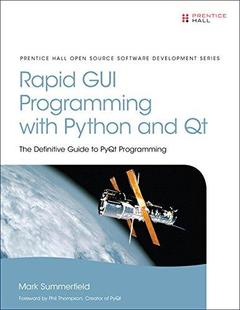Rapid GUI Programming with Python and Qt The Definitive Guide to PyQt Programming
Auteur : Summerfield Mark

The Insider's Best-Practice Guide to Rapid PyQt 4 GUI Development
Whether you're building GUI prototypes or full-fledged cross-platform GUI applications with native look-and-feel, PyQt 4 is your fastest, easiest, most powerful solution. Qt expert Mark Summerfield has written the definitive best-practice guide to PyQt 4 development.
With Rapid GUI Programming with Python and Qt you'll learn how to build efficient GUI applications that run on all major operating systems, including Windows, Mac OS X, Linux, and many versions of Unix, using the same source code for all of them. Summerfield systematically introduces every core GUI development technique: from dialogs and windows to data handling; from events to printing; and more. Through the book's realistic examples you'll discover a completely new PyQt 4-based programming approach, as well as coverage of many new topics, from PyQt 4's rich text engine to advanced model/view and graphics/view programming. Every key concept is illuminated with realistic, downloadable examples?all tested on Windows, Mac OS X, and Linux with Python 2.5, Qt 4.2, and PyQt 4.2, and on Windows and Linux with Qt 4.3 and PyQt 4.3.
Coverge includes
- Python basics for every PyQt developer: data types, data structures, control structures, classes, modules, and more
- Core PyQt GUI programming techniques: dialogs, main windows, and custom file formats
- Using Qt Designer to design user interfaces, and to implement and test dialogs, events, the Clipboard, and drag-and-drop
- Building custom widgets: Widget Style Sheets, composite widgets, subclassing, and more
- Making the most of Qt 4.2's new graphics/view architecture
- Connecting to databases, executing SQL queries, and using form and table views
- Advanced model/view programming: custom views, generic delegates, and more
- Implementing online help, internationalizing applications, and using PyQt's networking and multithreading facilities
- Part I: Python Programming
- Chapter 1. Data Types and Data Structures
- Executing Python Code
- Variables and Objects
- Numbers and Strings
- Collections
- Built-in Functions
- Chapter 2. Control Structures
- Conditional Branching
- Looping
- Functions
- Exception Handling
- Chapter 3. Classes and Modules
- Creating Instances
- Methods and Special Methods
- Inheritance and Polymorphism
- Modules and Multifile Applications
- Part II: Basic GUI Programming
- Chapter 4. Introduction to GUI Programming
- A Pop-Up Alert in 25 Lines
- An Expression Evaluator in 30 Lines
- A Currency Converter in 70 Lines
- Signals and Slots
- Chapter 5. Dialogs
- Dumb Dialogs
- Standard Dialogs
- Smart Dialogs
- Chapter 6. Main Windows
- Creating a Main Window
- Handling User Actions
- Chapter 7. Using Qt Designer
- Designing User Interfaces
- Implementing Dialogs
- Testing Dialogs
- Chapter 8. Data Handling and Custom File Formats
- Main Window Responsibilities
- Data Container Responsibilities
- Saving and Loading Binary Files
- Saving and Loading Text Files
- Saving and Loading XML Files
- Part III: Intermediate GUI Programming
- Chapter 9. Layouts and Multiple Documents
- Layout Policies
- Tab Widgets and Stacked Widgets
- Splitters
- Single Document Interface(SDI)
- Multiple Document Interface(MDI)
- Chapter 10. Events, the Clipboard, and Drag and Drop
- The Event-Handling Mechanism
- Re-implementing Event Handlers
- Using the Clipboard
- Drag and Drop
- Chapter 11. Custom Widgets
- Using Widget Style Sheets
- Creating Composite Widgets
- Subclassing Built-in Widgets
- Subclassing QWidget
- Chapter 12. Item-Based Graphics
- Custom and Interactive Graphics Items
- Animation and Complex Shapes
- Chapter 13. Rich Text and Printing
- Rich Text Editing
- Printing Documents
- Chapter 14. Model/View Programming
- Using the Convenience Item Widgets
- Creating Custom Models
- Creating Custom Delegates
- Chapter 15. Databases
- Connecting to the Database
- Executing SQL Queries
- Using Database Form Views
- Using Database Table Views
- Part IV: Advanced GUI Programming
- Chapter 16. Advanced Model/View Programming
- Custom Views
- Generic Delegates
- Representing Tabular Data in Trees
- Chapter 17. Online Help and Internationalization
- Online Help
- Internationalization
- Chapter 18. Networking
- Creating a TCP Client
- Creating a TCP Server
- Chapter 19. Multithreading
- Creating a Threaded Server
- Creating and Managing Secondary Threads
- Impleme
Mark Summerfield works as an independent trainer and consultant specializing in C++, Qt, Python, and PyQt. He was Trolltech’s documentation manager from 2000 to 2004, was the founding editor of Qt Quarterly, Trolltech’s customer newsletter, and coauthored C++ GUI Programming with Qt 3 and C++ GUI Programming with Qt 4.
- Python basics for every PyQt developer: data types, data structures, control structures, classes, modules, and more
- Core PyQt GUI programming techniques: dialogs, main windows, and custom file formats
- Using Qt Designer to design user interfaces, and to implement and test dialogs, events, the Clipboard, and drag-and-drop
- Building custom widgets: Widget Style Sheets, composite widgets, subclassing, and more
- Making the most of Qt 4.2's new graphics/view architecture
- Connecting to databases, executing SQL queries, and using form and table views
- Advanced model/view programming: custom views, generic delegates, and more
- Implementing online help, internationalizing applications, and using PyQt's networking and multithreading facilities
Date de parution : 10-2015
Ouvrage de 648 p.
18.1x22.8 cm
Disponible chez l'éditeur (délai d'approvisionnement : 14 jours).
Prix indicatif 57,17 €
Ajouter au panier


